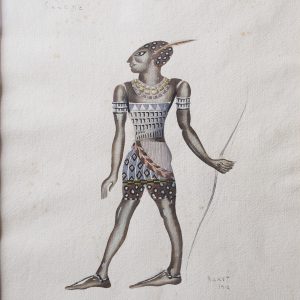Oval miniature painted on ivory, depicting the brother of King Louis XVI in bust, three-quarters to the right, dressed in a purplish silver coat and a white tie with a muslin frill edged with lace, bearing the orders of the Fleece gold (bottom right, red ribbon) and Saint-Lazare and Notre-Dame du Mont-Carmel (bottom center, amaranth ribbon), on a gray background.
Original 18k gold band engraved with interlacing.
Good condition.
Bears a signature on the left in red: hall.
Gross weight: 11.9 g. H. 4.5 x L. 3.5 cm (5.2 x 4.3 cm with frame).
- Théodore Dablin (1781-1861).
- Then kept in the collection of his heirs (inventory label n°261).
- Although the physiognomy makes us think, at first glance, of his older brother Louis XVI, with whom we often confuse him, several elements make us lean for the count of Provence. First, he was overweight, which he had very early unlike his older brother; brown eyes, while Louis XVI had light blue eyes; and especially the presence of the order of Saint-Lazare which he seems to wear in a tie, as always from 1773, date on which he became grand master at the advent of his elder brother on the throne of France.
- Our portrait, although signed Hall, seems to be a work slightly later than the period from 1775-1780 when it should have been made. There is little recognition of the virtuosity of the Swedish artist, who rarely signed his portraits. The source of our miniature may be compared to the portrait of Duplessis made around 1778 (see image 4), of which there are several versions, notably in red coat (see image 5), his decorations are worn elsewhere in the same place.
Pierre-Adolphe Hall was born in 1739 in Boras, Sweden. He went to Paris in 1766, where his compatriot Alexandre Roslin introduced him to good society, he was admitted to the Royal Academy in 1769. In 1771, he married the daughter of a wealthy Versailles merchant. His talent immediately points this out. With his broad touch and his sense of color, he renews the art of miniature, so much so that Diderot will describe it as "Van Dyck of miniature". Exceptionally gifted, the artist works on various supports and revolutionizes the miniature technique by introducing ivory as a support. He quickly attracted the attention of the Court, where he produced portraits of different people, including the three royal princes, Berry, Provence and Artois, respectively future Louis XVI, Louis XVIII and Charles X. He participated in the Salons de Toulouse and Paris. The Revolution will put an end to this meteoric career. Indeed, its clientele disperses in emigration. He joined the National Guard. Then, after having vainly tried his luck with the king of Sweden, it was in Belgium that he ended up. He died in Liège in 1793, aged 54, far from his family who had stayed in France.
Pierre Adolphe Hall kicked off his art. With him begins the golden age of the miniature, which will only end with the advent of the daguerreotype.
Among the portraits of the Royal Family, let us quote that of the snuffbox of the Louvre representing King Louis XVI circa 1776-1777 (OA 6850), unsigned. Also on a snuffbox in the Louvre, the count of Artois (RF 5013), unsigned. The only known portrait of the younger Count of Provence, exhibited at the Salon of 1769 and signed, is found in Prague at the Narodni Galerie (inv. NG DK 5841).
The legacy to The Louvre of Théodore DABLIN in 1861 notably included an enameled gold snuffbox decorated with a miniature portrait of King Louis XVI by P.-N. Violet (1749-1819) (inv. OA64), and a miniature portrait of a woman by Hall (inv. MI816).
Bibliography:
Régine de PLINVAL de GUILLEBON, Pierre-Adolphe Hall (1739- 1793), Léonce-Laget editions, 2000, chap. II.











